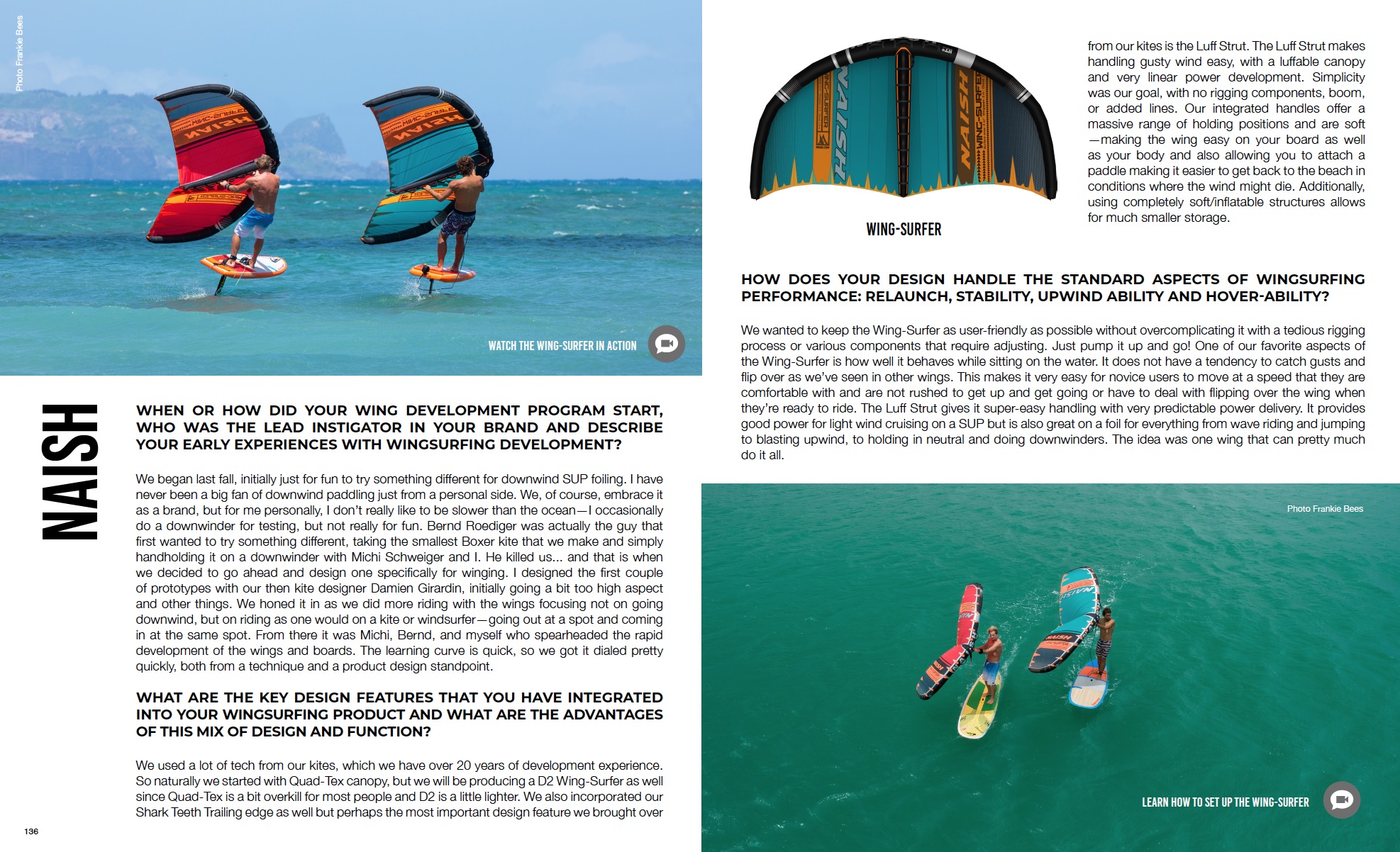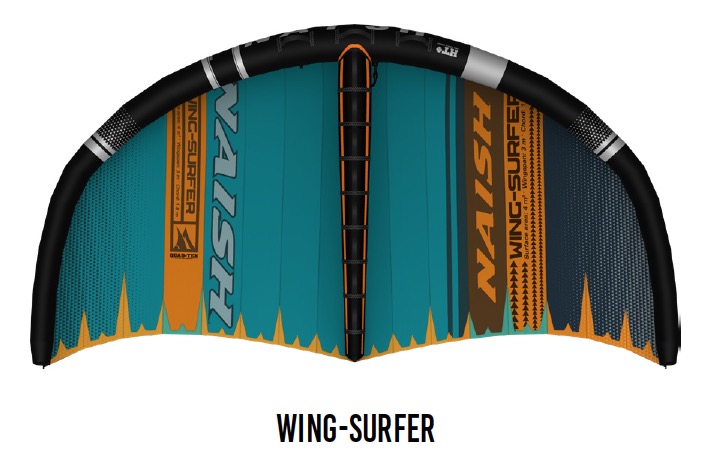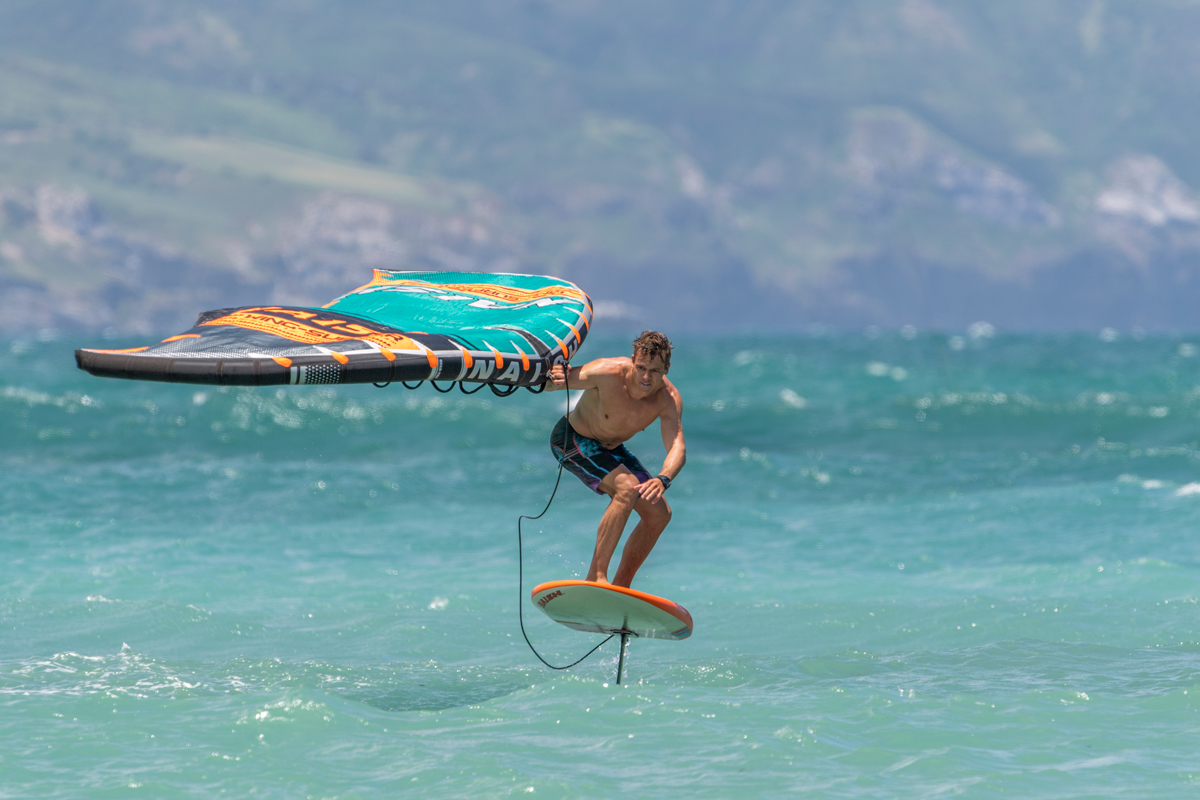 WHEN OR HOW DID YOUR WING DEVELOPMENT PROGRAM START, WHO WAS THE LEAD INSTIGATOR IN YOUR BRAND AND DESCRIBE YOUR EARLY EXPERIENCES WITH WINGSURFING DEVELOPMENT?
WHEN OR HOW DID YOUR WING DEVELOPMENT PROGRAM START, WHO WAS THE LEAD INSTIGATOR IN YOUR BRAND AND DESCRIBE YOUR EARLY EXPERIENCES WITH WINGSURFING DEVELOPMENT?
We began last fall, initially just for fun to try something different for downwind SUP foiling. I have never been a big fan of downwind paddling just from a personal side. We, of course, embrace it as a brand, but for me personally, I don’t really like to be slower than the ocean—I occasionally do a downwinder for testing, but not really for fun. Bernd Roediger was actually the guy that first wanted to try something different, taking the smallest Boxer kite that we make and simply handholding it on a downwinder with Michi Schweiger and I. He killed us… and that is when we decided to go ahead and design one specifically for winging. I designed the first couple of prototypes with our then kite designer Damien Girardin, initially going a bit too high aspect and other things. We honed it in as we did more riding with the wings focusing not on going downwind, but on riding as one would on a kite or windsurfer—going out at a spot and coming in at the same spot. From there it was Michi, Bernd, and myself who spearheaded the rapid development of the wings and boards. The learning curve is quick, so we got it dialed pretty quickly, both from a technique and a product design standpoint.
Watch Naish’s 2020 Foil and Wing-Surfer Product Preview from AWSI
WHAT ARE THE KEY DESIGN FEATURES THAT YOU HAVE INTEGRATEDÂ INTO YOUR WINGSURFING PRODUCT AND WHAT ARE THE ADVANTAGESÂ OF THIS MIX OF DESIGN AND FUNCTION?
We used a lot of tech from our kites, which we have over 20 years of development experience. So naturally we started with Quad-Tex canopy, but we will be producing a D2 Wing-Surfer as well since Quad-Tex is a bit overkill for most people and D2 is a little lighter. We also incorporated our Shark Teeth Trailing edge as well but perhaps the most important design feature we brought over from our kites is the Luff Strut. The Luff Strut makes handling gusty wind easy, with a luffable canopy and very linear power development. Simplicity was our goal, with no rigging components, boom, or added lines. Our integrated handles offer a massive range of holding positions and are soft—making the wing easy on your board as well as your body and also allowing you to attach a paddle making it easier to get back to the beach in conditions where the wind might die. Additionally, using completely soft/inflatable structures allows for much smaller storage.
 HOW DOES YOUR DESIGN HANDLE THE STANDARD ASPECTS OF WINGSURFINGÂ PERFORMANCE: RELAUNCH, STABILITY, UPWIND ABILITY AND HOVER-ABILITY?
HOW DOES YOUR DESIGN HANDLE THE STANDARD ASPECTS OF WINGSURFINGÂ PERFORMANCE: RELAUNCH, STABILITY, UPWIND ABILITY AND HOVER-ABILITY?
We wanted to keep the Wing-Surfer as user-friendly as possible without overcomplicating it with a tedious rigging process or various components that require adjusting. Just pump it up and go! One of our favorite aspects of the Wing-Surfer is how well it behaves while sitting on the water. It does not have a tendency to catch gusts and flip over as we’ve seen in other wings. This makes it very easy for novice users to move at a speed that they are comfortable with and are not rushed to get up and get going or have to deal with flipping over the wing when they’re ready to ride. The Luff Strut gives it super-easy handling with very predictable power delivery. It provides good power for light wind cruising on a SUP but is also great on a foil for everything from wave riding and jumping to blasting upwind, to holding in neutral and doing downwinders. The idea was one wing that can pretty much do it all.
WHAT APPROACH HAVE YOU TAKEN TO WING SIZING, AND HOW DO YOU RECOMMENDÂ THE VARIOUS SIZED WINGS TO YOUR POTENTIAL BUYERS?
The Wing-Surfer currently only comes in a 4m—through testing we found this to be the perfect size for both foiling and just SUPing. The Wing-Surfer has a massive range thanks to the Luff Strut which allows the wing’s canopy to expand and contract in gusty conditions. The Wing-Surfer has been tested in winds from 10 to 30 knots. To handle different wind speeds while foiling we actually change foil wing sizes instead, so if we’re in strong winds we will run a smaller wing like the Jet 1250 or even the Windsurf 1150, while in lighter winds we will jump up to the Jet 1650 or 2000 wing. There will certainly be a lot of development in the future as the “sport†grows…. but initially, we wanted to introduce the sport with a single product in a single size that will suit the vast majority of people of different skill levels from the get-go.

Photo: Frankie Bees
HOW DOES THE WING INTERMIX WITH YOUR CURRENT OFFERING OF FOIL WINGÂ AND FOILBOARD DESIGNS AND WHAT WILL BE YOUR FUTURE APPROACH TO BOARDÂ SIZING, VOLUME AND FEATURES?
As mentioned previously, the Wing-Surfer has been an incredible compliment to our foiling program which has grown substantially in 2020. This year we are offering the Jet Surf in 1050, 1250, 1650, 2000 and 2450 sizes as complete packages and they’re all modular, so you can get additional wings to cater to whatever conditions you’re foiling. Additionally, each complete foil comes with a case with slots for storing multiple wings. You can wing on any SUP in light winds and of course match it to a foil and foil board for more advanced riders. With some practice, you can ride a pretty small board so long as it is windy enough to slowly lift yourself out of the water and up onto the wing. But the most sensible board size is to take what will float you well enough to get in and out just through static flotation. I ride a 95 liter most of the time. Most people are riding between 95 and 130 liters. You want to be able to get back to the beach if the wind drops.
Tkb’s 2020 Wingsurf Buyer’s Guide is included within the pages of our 2020 Buyer’s Guide. Want more 2020 gear info? Get the latest product tech from all the top brands all in one convenient place.Â
